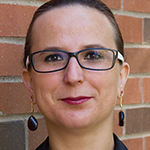Multi-disciplinary team aims to bring new tech tools to the classroom in effort to prepare students for real-world challenges
 |
 |
 |
(From left to right): Faculty members Aliye Karabulut, Chuck Jahren
|
||
“Students are motivated when things make sense and are relevant,” says Chuck Jahren, Iowa State University’s (ISU) Construction Engineering Professor-in-Charge.
Jahren has been teaching courses at ISU for the past 24 years. He has a firm handle on what drives a student.
That is why he and a team of researchers are working to bring mobile augmented reality (AR) to classrooms. The National Science Foundation has awarded the group nearly $300,000 for its project “Collaborative Research: Transforming Teaching of Structural Analysis through Mobile Augmented Reality.”
Jahren forms the shape of a beam with his hands, explaining the concept of components and whole structures as taught in a structural engineering course.
“Students will still design at a component level, but before they design the component, they will be able to visualize the entire structure and see how that component fits in, and when the forces will be imposed on it,” he says.
That is the idea behind the group’s project.
How it works
Starting in August of this year, the researchers started developing computer-generated AR models. Those models superimpose on surfaces using a tablet or iPad®. Students open an application, hold the tablet up to a structure (e.g. Town Engineering Building, Iowa State’s Campanile, the skywalk between Howe Hall and Hoover Hall), see the underlying components (beams, columns, etc.) and observe how structural elements behave under different types of loading conditions. Those conditions include wind load and seismic load.
“We envision this will not replace everything in the classroom,” says An Chen, a civil engineering assistant professor and the principal investigator of the project. He teaches Civil Engineering Structural Analysis I (CE 332), the class in which the researchers will ultimately test their AR applications. “We believe this will be a resource, a supplementary material that the instructor or the students can choose to use.”
Testing
After the development of applications, the researchers will test the effectiveness of AR as a tool for learning. In a controlled environment, one group of students will use the applications to learn a structural engineering topic. Another group will learn the same topic through traditional lecture methods, which include concept presentations through 2-D visuals and example problem solving.
“The idea behind augmented reality is that it addresses different learning styles because it gives different experiences to students,” Aliye Karabulut-Ilgu, a lecturer in civil, construction and environmental engineering, oversees the pedagogic aspects of the research. “They can look at it, they can feel it, they can experience it.”
Multi-discipline team
In addition to Chen, Jahren and Karabulut-Ilgu, ISU Mechanical Engineering Assistant Professor Rafael Radkowski leads the development of the AR application. Oregon State’s Assistant Professor Yelda Turkan leads 3-D design and Associate Professor Amir Behzadan of Texas A & M provides guidance on AR development and classroom implementation. The project is estimated to last through July 2019.
More information about ISU CCEE research can be found on our website, www.ccee.iastate.edu. And visit us on our Facebook, Twitter and LinkedIn pages as well (Iowa State University Civil, Construction and Environmental Engineering and ISUConE).